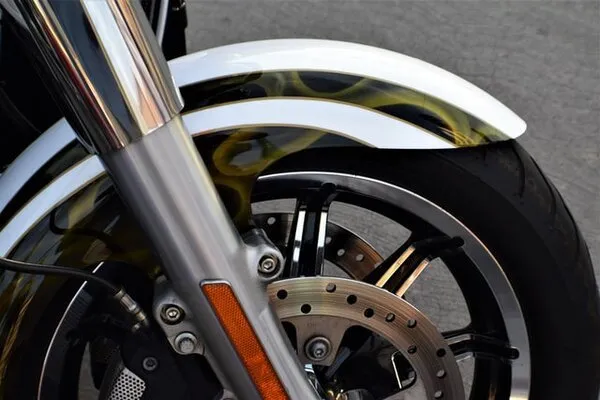Thinking about how to replace motorcycle fork seals? It’s not that it’s unsafe to ride your motorcycle with leaking fork seals. The matter is slightly different here. With leaking fork seals, the oil will run down on the brakes. It means the brakes won’t function properly. So, the ride will become unsafe.
You can ride your motorcycle with leaking fork seals, but as long as you are not performing any stunts, everything will be okay. But riding like this means you are at a significant disadvantage with up to 70% less stopping power. So, it’s a matter of safety, and you shouldn’t ride your bike with no stopping power.
But how to fix these leaking fork seals? In the following section, we will discuss this matter.
How to Look After Motorcycle Forks?
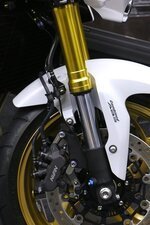
Before you find how to replace motorcycle fork seals, you need to know how to take care of them. Your motorcycle forks are your front shock absorbers. So, they suspend your bike right on top of your front wheel and are integral for your overall riding comfort. But most riders don’t take care if these forks wear out quickly unless they give some uncomfortable riding experience.
The tube that is inside the lower leg moves with a spring along with the fork oil. This fork oil lubricates everything inside the fork system. You need to get rid of the dirt and debris that can get into the lower leg area where the fork seal is. Keep the tubes clean and use WD-40 as it will keep the debris away from the fork oil.
How Long Fork Oil, Seals, and Bushes of Motorcycles Last?

If you take proper care of your fork oil, seals, and bushes, they can easily last up to four years. But the care and maintenance need to be done thoroughly with WD-40. This fluid can get rid of any dirt or debris with ease.
If you ride a lot, you need to service your fork system every couple of years. But in any case, you will have to be thorough in your service to make sure you don’t have to deal with any fork seal leakages later on. If you ride in rough conditions and do a lot of riding, you need to service annually.
When Should I Replace Fork Seals and Bushes?
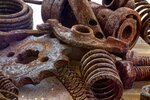
Replace them for a safe bet after three years if you don’t ride much. But if you ride a lot, you need to replace them annually, especially if the conditions are rough. Otherwise, the seals will break, and the fork oil will begin to leak.
Therefore, it would be better to go for a replacement after a couple of services; that is the rule of thumb that most professional riders and experts follow. So, after a couple of regular services, you need to replace your fork seals and bushings.
How to Replace Motorcycle Fork Seals – Step-by-Step
Looking for some information on how to replace motorcycle fork seals? It’s not that difficult if you follow our step-by-step guide. Properly maintaining your motorcycle will keep it safe and improve its overall handling.
We won’t have any issues in changing the engine oil of our motorcycle. But most of us haven’t even heard about fork oil in our bike’s front suspension system. You won’t be able to service them unless you have special tools.
No matter how much you take care of your fork system and oil them properly, it will fail at some stage. So, here’s how you can fix this issue.
What parts do you need to work on?
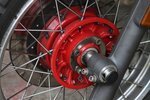
You have to make sure that you work on your bushes and seals in pairs. If one of the two legs shows some signs of problems, the other will not be that far either. A fork dust seal pair will not cost you a lot, and similar is the case with oil seals.
There is a common misconception that replacing the dust seal will be more than enough to get the job done. Replacing these dust seals won’t solve this issue. But it feels catchy because you won’t need to take the forks apart if you only replace the dust seals. And this idea is the source of the misconception.
It would be better to replace the sand ring on both the legs that hold those oil seals. Apart from that, you will also need to replace a couple of inner and outer bushes. If you are looking for some signs of damage on the fork stanchion, you will have to replace that too. The best fork leg is straight, but you need to replace if you see it is creased.
And last but not least is the oil, and you can also consult your owner’s manual for the correct oil weight (usually 10W). The manual will also guide you on how much oil you should put in the tube.
Step 1 – Winding offspring preload and screwing down rebound adjuster

When setting the preload back in its original position, you need to count the turns of winding. You also need to wind the screw for rebound adjustment. This will make the job lot easier later on when trying to set the height for the top cap.
After that, you will need to loosen your bike’s top caps if you remove the fork from your bike. But keep in mind you don’t need to reduce the bolts for the bottom yoke. You only have to crack them open but make sure not to grip the stanchions.
Step 2 – Removing forks and bottom bolt

The next step is to remove the forks carefully, as you would have already taken the wheel out of the frame. Carefully remove the mudguards, calipers and make sure if the lines are under any strains.
After that, you need to turn your attention to removing the bolts. You will have to likely look at your bike’s assembly and its make because different bikes have different styles of assembly, especially the older ones.
Step 3 – Drain the old oil, dust seal, snap ring,
The next step is quite simple. You need to get rid of the old oil and the oil seal. You can use your flat-bladed screwdriver here and, in the end, remove the snap ring as well.
Step 4 – Pull out the fork stanchion and remove the seals and bushes
The next step is to pull the fork stanchion out but be careful not to put too much force on it as it’s a delicate component. Even a little scratch will make you change it for good. And in the end, you need to remove the bushes and seals as well. Don’t forget about removing the cartridge from the stanchion as well.
Step 5 – Fixing any pitting and cleaning everything
You need to make sure all these components you have taken apart are clean and fix any pitting. The best cleaner in this regard is the WD-40. You can use it comfortably on all components without any issues.
Step 6 – Fitting the new bush and refitting the cartridge along with the new oil seal
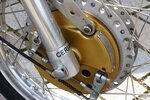
When you are disassembling, you need to keep in mind which part goes where and use the owner’s manual for assistance. After a thorough clean, it’s time to fit the new bush in and refit the cartridge. And take the new oil seal and fit it right in.
Step 7 – Fitting the clip and the dust seal and priming the cartridge
The next step is to fit the retaining clip back in alignment with the dust seal, and then you need to fit the cartridge. Set the right air gap, for which you also need to consult your owner’s manual and check the lock nut in the top cap.
Step 8 – Fitting the spring and finishing up
After that, you need to fit the spring in and screw the top cap and the fork stanchion with the fork cap. Tighten the fork caps in the end, and you are all done.
FAQ
Are fork seals hard to replace?
If you have some do-it-yourself experience, you can get the job done efficiently. Just make sure you do some research first and find all the parts and tools you will need.
Can I ride my motorcycle with leaking fork seals?
You can ride your motorcycle with leaking fork seals, but the fluid will be on the brakes, and your bike has lost up to 70% of its stopping power, so it will not be safe to ride on your bike.
How do I stop my fork from leaking?
You need to clear the fork tubes from dust and debris, and for that, you need to service your fork suspension system every couple of years regularly.
What happens if you don’t replace fork seals?
Your bike loses a lot of stopping power due to the leaking oil going on the brakes. Your front suspensions will start lagging as well, and it will damage the entire fork system.
Can I change fork oil without removing the forks?
First, you will have to determine where your fork legs have drain plugs at the bottom. If they do, you can change the fork oil without removing forks from the top caps on the fork tubes.
Conclusion
So, if you are still thinking, “can I ride my motorcycle with leaking fork seals,” you can do so for reaching the mechanic or home. How to replace motorcycle fork seals is not that difficult if you follow the assembly instructions carefully. Just make sure you have the right tools and parts available before you begin the process.

